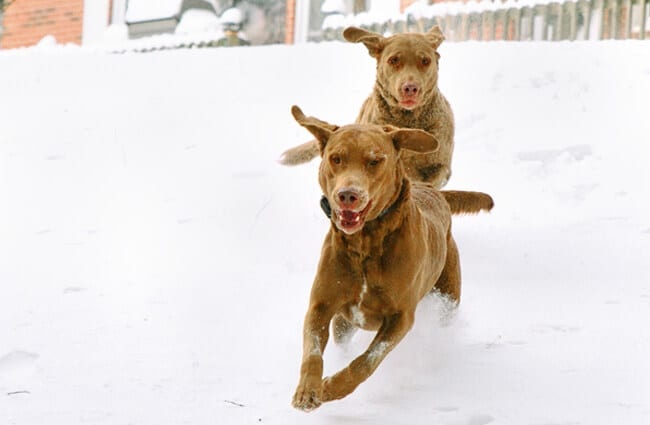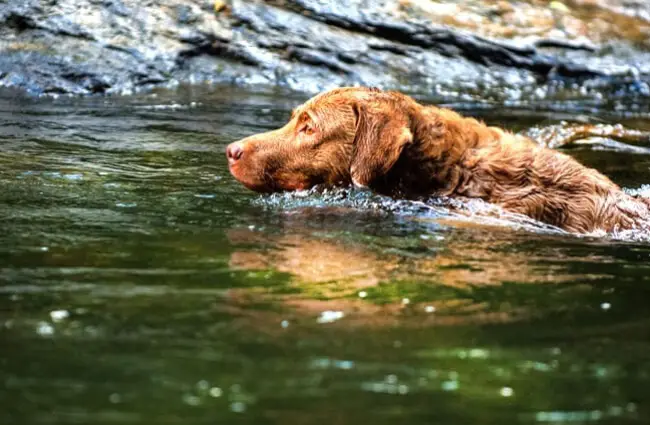A Deep Dive into the Chesapeake Bay Retriever
The Chesapeake Bay Retriever, often simply called a “Chessie,” is a powerfully built, intelligent, and remarkably capable dog breed with a fascinating history and a unique set of characteristics. Originating in the United States, this breed was not developed over centuries like many others but rather through a focused effort in the 19th century to create the ultimate waterfowl retriever. Their story is one of resilience, adaptation, and unwavering dedication to the task for which they were bred.

History and Origins
The story begins in the early 1800s, when British sportsmen imported water dogs to the Chesapeake Bay region of Maryland and Virginia. These dogs—believed to include ancestors of the Newfoundland, English Water Spaniel, Irish Water Spaniel, and some North American otterhound types—were interbred with local dogs. The goal was to produce a dog capable of retrieving waterfowl in the harsh conditions of the bay—icy water, strong currents, and dense marshlands.
The result was a remarkably hardy and capable retriever. Unlike many breeds refined for aesthetics, the Chessie was shaped by function. Dogs that lacked the stamina, drive, or water resistance needed for the task simply didn’t survive the breeding program. By the mid-19th century, the Chesapeake Bay Retriever had established itself as a distinct and highly valued breed, prized by market gunners and sportsmen alike. The American Kennel Club officially recognized the breed in 1878.
Physical Characteristics
Chesapeake Bay Retrievers are medium to large dogs built for power and endurance. Males typically stand 23 to 26 inches at the shoulder and weigh 70 to 80 pounds. Females are slightly smaller, measuring 21 to 24 inches and weighing 55 to 70 pounds. Their most distinctive feature is their waterproof double coat, which is wavy or curly and ranges in color from a rich brown to a lighter reddish‑brown.

The coat isn’t merely for warmth; the oily texture repels water, preventing the dog from becoming waterlogged and chilled. They also possess webbed feet, further enhancing their swimming ability. Their strong, muscular build, deep chest, and powerful legs enable them to navigate challenging terrain and swim for extended periods. A unique characteristic is the “otter tail”—relatively long, thick at the base, and tapering toward the tip—which acts as a rudder in the water.
Temperament and Behavior
Chesapeake Bay Retrievers are known for their intelligence, courage, and independence. They are devoted to their families but can be somewhat reserved with strangers. This wariness makes them excellent watchdogs, though early socialization is crucial to ensure they are well‑adjusted and friendly.
These are energetic dogs that require plenty of exercise. They thrive on having a job to do, whether it’s retrieving, swimming, or participating in canine sports. Without sufficient mental and physical stimulation, they can become bored and destructive. Their intelligence means they learn quickly, but their independent nature can sometimes translate into stubbornness. Consistent, positive reinforcement training is essential.

A particularly noteworthy aspect of the Chesapeake Bay Retriever’s temperament is its “protective instinct.” Bred to work independently in challenging conditions, they are capable of making their own decisions. This can be a positive trait in certain situations, but it also means they require a confident and experienced owner who can provide clear leadership.
Care and Maintenance
Chesapeake Bay Retrievers require a moderate amount of grooming. Their double coat needs brushing several times a week to prevent matting and remove loose hair. During shedding season—typically spring and fall—daily brushing is essential. They also need regular nail trims, ear cleaning, and dental care.
Beyond grooming, consider these important aspects:
- Exercise: At least one to two hours of vigorous exercise daily is crucial.
- Diet: A high‑quality dog food formulated for active breeds is recommended.
- Training: Start early with socialization and obedience training.
- Health: Be aware of potential health concerns such as hip dysplasia, progressive retinal atrophy, and hypothyroidism. Regular veterinary checkups are vital.

Suitability as a Pet
Chesapeake Bay Retrievers are best suited for active families who can provide them with plenty of exercise, mental stimulation, and consistent training. They do well in homes with yards, especially those near water. They can be good with children, but early socialization and supervision are essential. Their protective instincts may lead them to be wary of strangers, so proper introductions are crucial.
While they can live in apartments, it is not ideal. They need space to move and exercise. Potential owners should also be prepared for a dog that may be somewhat independent and stubborn at times. A patient and experienced owner who understands the breed’s unique characteristics is essential.
Beyond the Basics: Advanced Traits & Considerations
For those considering a Chesapeake Bay Retriever for more than just companionship, it is important to understand some advanced traits:
- Scent Detection: Their keen sense of smell makes them excellent candidates for scent work, including tracking and retrieving dummies.
- Water Work Specialization: Beyond retrieving, they excel in water rescue and dock diving.
- Trainability Nuances: While intelligent, they can become easily bored with repetitive training. Keep sessions short, engaging, and reward‑based. Focus on building a strong bond based on trust and respect.
- Potential for “Soft Mouth” Issues: Historically bred to retrieve game without damaging it, some Chessies may exhibit a tendency to gently mouth objects. This can be a positive trait, but it requires consistent training to prevent them from picking up and carrying inappropriate items.

The Chesapeake Bay Retriever is a remarkable breed, steeped in history and brimming with personality. They are more than just beautiful dogs; they are intelligent, courageous, and capable companions. For the right owner, a Chessie can bring years of joy, companionship, and unwavering loyalty.






![Red Angus Closeup of a beautiful Red Angus cowPhoto by: U.S. Department of Agriculture [pubic domain]https://creativecommons.org/licenses/by/2.0/](https://animals.net/wp-content/uploads/2020/03/Red-Angus-4-100x75.jpg)

